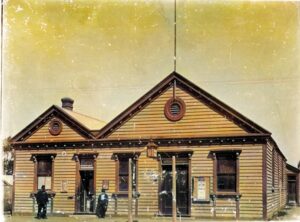1871: Rangiora Literary Institute
May 10, 2024
By AHNZ
 Rangiora Literary Institute was created this month in New Zealand history, May 1871. The building was opened on New Years Day 1873 and started to take over and extend executive functions of the North Canterbury community.
Rangiora Literary Institute was created this month in New Zealand history, May 1871. The building was opened on New Years Day 1873 and started to take over and extend executive functions of the North Canterbury community.
According to Hawkins (1983) the founding principles were to preserve Rangiora’s supposed status quo of “general sobriety, honesty, industry and religion.” It was located very near to the present Rangiora Library and Waimakariri District Council buildings. Also, it was built on the opposite side of High Street to the Road Boad Office that had been the previous locus of Rangiora imperium.
Founders such as Merton, Cunningham, Blackett, Boys were perhaps shifting some power from an earlier generation of leaders. The concert room, ballroom, reading room, library, and hall functions made it the new locus of community attention rather than the smaller old Road Board office it displaced.
Once up and running the Institute took over the public functions of the Court House and became the new venue for lectures, electioneering, and public functions too. It was here that the Rangiora Borough Council was conceived that made the Mandeville and Rangiora Road Board (1864) obsolete. The Institute now became the seat of power for the Rangiora Borough Council (1878) having initially marked its territory by meeting at the Road Board offices and slowly digesting its assets over the course of months.
Captain Albert Parsons (1829-1897) was the last chairman of the Road Board. Shopkeeper Henry Blackett (1820-1907) became the first Mayor of Rangiora. I think their acquisition of power into this, their new castle, was anything but sober, honest, or religious. And, quite a long way from how local government started out under the chairmanship of Reverend John Raven. Since the 1876 dissolution of the Canterbury Provincial Council there had been a power vacuum to fill with men like Blackett coming out on top all over New Zealand.
The Literary Institute was not created by The State but it was built and paid for by men in hot pursuit of State power.
“Take a look at a castle. Any castle. Now break down the key elements that make it a castle. They haven’t changed in a thousand years. 1: Location. A site on high ground that commands the territory as far as the eye can see. 2: Protection. Big walls, walls strong enough to withstand a frontal attack. 3: A garrison. Men who are trained and willing to kill. 4: A flag. You tell your men you are soldiers and that’s your flag. You tell them nobody takes our flag. And you raise that flag so it flies high where everyone can see it. Now you’ve got yourself a castle.” – The Last Castle (2001)
“The aspirations of those settlers who had come to Rangiora earlier were to be seen among the founding principles of the Literary Institute which was formed in May 1871 by Charles Merton and A.H. Cunningham and their colleagues, and who hoped not only to encourage the improvement of its members by lectures, readings and musical entertainment but that through the Institute – ‘Rangiora might preserve all the good qualities it now possesses – general sobriety, honesty, industry and religion.’ The gentlemen of the Literary Institute raised the money for a hall which was built in High Street, almost opposite the lane which later became Durham Street, and which was opened on New Years Day 1873….If there was an ‘establishment’ developing in the town then the ‘Literary Institute’ was probably near the heart of it.”
“After 1873 the Institute Hall took over the public functions of the Court House, a larger chamber in the Road Board office, where meetings, electioneering and lectures had previously been held. The Road Board office stood on the opposite side of the road, down past Blackett’s store. The Magistrates Court sat here every second week…” – Rangiora, Don Hawkins (1983)

The surviving photo we have shows policemen in attendance of the Insistute and a tall flagpole.
There is some doubt that literature, sobriety, and religion were the true goals of the Institute. Rather, that these were the token deities to which one had to tip one’s hat in the 1870s in order to be on-message. If you can present yourself has having the image of whatever the Current Thing is then the public will go along with being taxed and ruled. Future incarnations of a place like this might have World War decorative motifs or psudo-Maori decorative facades or even ‘Rainbow Tick’ coloration to signal that your government is benign and representative of whatever the latest fad is. However, it’s what goes on inside buildings like these that really matters and that’s always the same and never any good!
Still, it’s tempting to think of an age long past where New Zealander were so intelligent and literary that books were the chosen disguise of government.
—
Image ref. Policemen attending to the Institute, Christchurch City Libraries. Colour by AHNZ (2024)
Image ref. Mandeville and Rangiora Road Board ‘logo’ lifted from 1880s map
 Like Comment Share
Like Comment Share





